 How is it July already?! I can’t believe it’s nearly a year since Simon and I started sailing home on Planet. And forget all thoughts of sunny Greece – if anyone’s thinking what nice weather we must have been having and bemoaning the wet June we’ve just seen here, it was about this time last year we were sheltering from downpours in Brittany and wondering if we’d already seen the last of the sun before home….we had!
How is it July already?! I can’t believe it’s nearly a year since Simon and I started sailing home on Planet. And forget all thoughts of sunny Greece – if anyone’s thinking what nice weather we must have been having and bemoaning the wet June we’ve just seen here, it was about this time last year we were sheltering from downpours in Brittany and wondering if we’d already seen the last of the sun before home….we had!
In the whirlwind that has been the last few weeks we have finished planking – very excitingly – and eventually scrubbed all the glue and epoxy off our forearms! Suddenly our boat became a whole entity rather than a collection of parts, and we even tried lifting her up a little in the workshop. Even still attached to the jig we could easily tilt her over with two of us lifting which bodes well for when we come to turn her over. She is lighter than I’d imagined, although there is still quite a bit of weight to add to her between now and the launch.
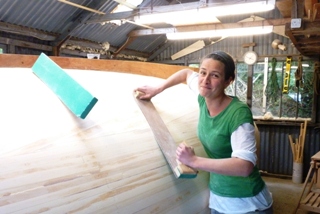 Fairing was next; sanding back rough edges of planks and covering ourselves and everything else in sawdust so that despite carefully draping tea towels over cups we somehow still found bits of cedar floating around in our tea. We were using longboards to do the fairing; vile oversized nail file-esque instruments of torture that sap the strength from your arms and make you wish you actually were using a nail file which is an unusual thing for either of us to do.
Fairing was next; sanding back rough edges of planks and covering ourselves and everything else in sawdust so that despite carefully draping tea towels over cups we somehow still found bits of cedar floating around in our tea. We were using longboards to do the fairing; vile oversized nail file-esque instruments of torture that sap the strength from your arms and make you wish you actually were using a nail file which is an unusual thing for either of us to do.
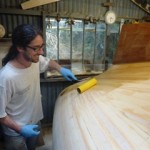 But they do a great job of sanding a hull and eventually we got a fair enough (excuse the pun) surface to call it a day and coat the hull with a layer of epoxy. This has to have been one of the most satisfying jobs so far; after planking and fairing it was a doddle and the results were awesome!
But they do a great job of sanding a hull and eventually we got a fair enough (excuse the pun) surface to call it a day and coat the hull with a layer of epoxy. This has to have been one of the most satisfying jobs so far; after planking and fairing it was a doddle and the results were awesome!
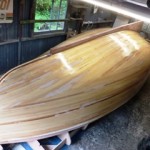 The last job before fibreglassing was to make and fit the stem. The stem is like the front bumper of a boat, except a bit more structural and attractive than the ones you find on cars. We made ours stem by laminating white oak which bends well and is strong and happy to be glued. Once again Bob Edwards was incredibly kind and helpful, sawing the large solid piece of oak into thin strips for us. We took a pattern for the stem off the boat, and using this made a jig on the workbench to fit the glued strips into to make the correct shape for our stem. Then, using a series of blocks we bent the strips into the jig and clamped it in place overnight.
The last job before fibreglassing was to make and fit the stem. The stem is like the front bumper of a boat, except a bit more structural and attractive than the ones you find on cars. We made ours stem by laminating white oak which bends well and is strong and happy to be glued. Once again Bob Edwards was incredibly kind and helpful, sawing the large solid piece of oak into thin strips for us. We took a pattern for the stem off the boat, and using this made a jig on the workbench to fit the glued strips into to make the correct shape for our stem. Then, using a series of blocks we bent the strips into the jig and clamped it in place overnight.
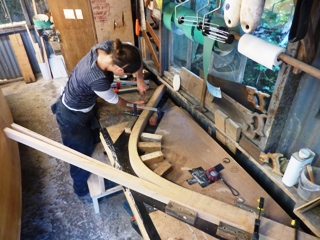 Going down to the workshop the following day to take our newly curved stem out of the jig was very exciting. Even though I knew the epoxy bonding would have cured and the oak would be glued in place in its new shape, it still seemed a bit implausible, albeit in a very pleasing way. Here was what looked like a solid piece of wood, yet it was secretly made up of lots of thin bits of wood which had once been part of the same tree. I had previously associated lamination with flooring and especially with a particularly well faded and since removed version of this in our conservatory, which was like looking at a photograph of wood through scratched, heavily tinted sunglasses. This new form of lamination couldn’t have been more different and we both marvelled at the beautiful oak for a while. Once we’d got over that, we fitted the stem, gave it a coat of epoxy and that’s where we’re up to now!
Going down to the workshop the following day to take our newly curved stem out of the jig was very exciting. Even though I knew the epoxy bonding would have cured and the oak would be glued in place in its new shape, it still seemed a bit implausible, albeit in a very pleasing way. Here was what looked like a solid piece of wood, yet it was secretly made up of lots of thin bits of wood which had once been part of the same tree. I had previously associated lamination with flooring and especially with a particularly well faded and since removed version of this in our conservatory, which was like looking at a photograph of wood through scratched, heavily tinted sunglasses. This new form of lamination couldn’t have been more different and we both marvelled at the beautiful oak for a while. Once we’d got over that, we fitted the stem, gave it a coat of epoxy and that’s where we’re up to now!
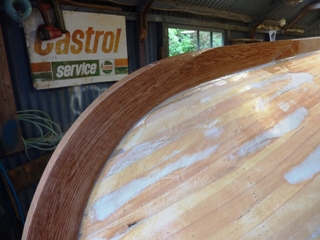 The next step is to coat the hull with fibreglass. This may sound counter intuitive given that we’ve spent a while building a boat out of wood but I can assure you it does make sense. We’re going to be using a biaxial glass cloth together with epoxy resin. Unlike polyester resin and glass systems (i.e. traditional fibreglass) the combination we’re using won’t shrink, absorb water or debond from the planking further down the line. Essentially it means we’ll end up with a boat with the benefits of both wooden and fibreglass boats but without the drawbacks. So the benefits of using wood mean that she was able to be built without needing a mould and is lighter than she would have been had she been built entirely from plastic. In addition, using fibreglass sheathing provides a barrier to stop water from getting in and therefore moisture being absorbed by the wood. It also gives us a more hard-wearing surface and a stronger boat.
The next step is to coat the hull with fibreglass. This may sound counter intuitive given that we’ve spent a while building a boat out of wood but I can assure you it does make sense. We’re going to be using a biaxial glass cloth together with epoxy resin. Unlike polyester resin and glass systems (i.e. traditional fibreglass) the combination we’re using won’t shrink, absorb water or debond from the planking further down the line. Essentially it means we’ll end up with a boat with the benefits of both wooden and fibreglass boats but without the drawbacks. So the benefits of using wood mean that she was able to be built without needing a mould and is lighter than she would have been had she been built entirely from plastic. In addition, using fibreglass sheathing provides a barrier to stop water from getting in and therefore moisture being absorbed by the wood. It also gives us a more hard-wearing surface and a stronger boat.
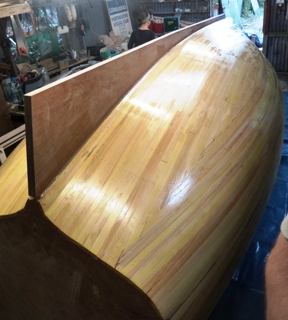 After fibreglassing, we’ll be painting her, turning her over and fairing, coating and painting her inside, as well as finishing rigging and spars and fitting her out with hardware. And then it’ll be time to launch her…..! We’ve finally decided on a date for this – with a certain amount of trepidation about the proximity of the deadline – and I’m happy to announce that it’s Sunday 19th August. This year! So put the date in your diaries and we’ll see you down at Tatum’s Beach in Portscatho then. More details to follow soon….
After fibreglassing, we’ll be painting her, turning her over and fairing, coating and painting her inside, as well as finishing rigging and spars and fitting her out with hardware. And then it’ll be time to launch her…..! We’ve finally decided on a date for this – with a certain amount of trepidation about the proximity of the deadline – and I’m happy to announce that it’s Sunday 19th August. This year! So put the date in your diaries and we’ll see you down at Tatum’s Beach in Portscatho then. More details to follow soon….
